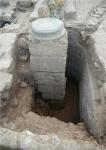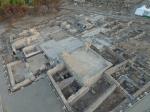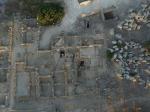Summary (English)
This was the 15th season of excavations undertaken by Milan University at Nora. This year it was decided to continue work in a number of “key” areas of the ancient city, and to open trenches in new areas to add to the understanding of the site and add to areas open to the public within the archaeological park.
In the Central Baths, the opening of small trial trenches in the new areas revealed stratigraphy that was useful for reconstructing the structure’s various phases of use. In particular, research took place in three rooms situated at the southern limit: To and Tq, occupied by two praefurnia of the south tepidarium and the caldarium, and a narrow service room between the first two. The excavations analysed part of the stratigraphy predating the construction of the baths, providing useful material for dating the earliest phases. A new section of the drain system was also excavated: a conduit covered by large stone blocks leading from the frigidarium area, which connected to the already known drain leading towards the sea.
In the “Casa del Direttore Tronchetti” (CdT) the excavation of the central courtyard revealed the presence of walls and floors pre-dating the Severan period, connected to a large “bath-tub shaped” cistern built of sandstone blocks. The cistern floor of terracotta based opus caementicium was exceptionally well preserved, as was the mortar revetment in which the ash substratum used to waterproof the structure could be glimpsed. The collapse of the north wall – that perhaps determined by the fact that the cistern went out of use just before the Severan reconstruction – made it possible to see how the structure was dug into the underlying bedrock.
A previously undiscovered quarter is coming to light between the “Casa del Direttore Tronchetti” and the “Terme a Mare”, occupied by one or more abandoned residential nuclei and levelled during the extensive Severan transformation. The 2016 and 2017 campaigns identified the remains of a first building formed by at least six rooms (temporarily named the “Casa del Pozzo”, CdP, due to the vicinity of the so-called “Pozzo nuragico”) certainly inhabited between the 1st and 2nd centuries A.D. This area is of fundamental importance for understanding the restructuring phases of the entire insula. In fact, the first studies have shown how some of the spaces in the CdP were used as a dump for building rubble from the nearby “Terme a Mare”, such as a fragment of white plaster bearing the graffiti of three numbers (III, VIII, VIIII) and the base of a small column of giallo antico, perhaps reworked as a floor element.The last intervention too place in the so-called “Case del Signino” (CdS), excavated by G. Pesce and again in 2016 by Milan University. This made it possible to reconstruct the spaces of a domus built around a large central courtyard, which can be associated with several commercial spaces opening onto the square in front. While excavations took place within the rooms of the domus, the walls and floors of the entire complex were recorded.
- Ilaria Frontori - Università degli Studi di Milano
Director
- Giorgio Bejor- Università degli Studi di Milano
Team
- Emilio Erba - Università degli Studi di Milano
- Giorgio Rea - Università degli Studi di Milano
- Luca Restelli - Università degli Studi di Milano
- Ilaria Frontori - Università degli Studi di Milano
- Gloria Bolzoni - Università degli Studi di Salerno
Research Body
- Università degli Studi di Milano, Dipartimento di Beni Culturali e Ambientali
Funding Body
- Università degli Studi di Milano, Dipartimento di Beni Culturali e Ambientali






![Download [PDF]](/excavation/skins/fasti/images/results/download_sml.png)

